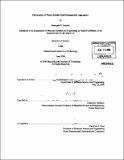Fabrication of water-soluble gold nanoparticle aggregates
Author(s)
Bennett, Samantha E
DownloadFull printable version (1.680Mb)
Other Contributors
Massachusetts Institute of Technology. Dept. of Materials Science and Engineering.
Advisor
Francesco Stellacci.
Terms of use
Metadata
Show full item recordAbstract
Mixed monolayer protected gold nanoparticles were linked using octanedithiol to form aggregates containing hundreds of nanoparticles. These aggregates are an interesting material, posing potential applications in the fields of chemistry, biology and materials science. This study examined the dependence of aggregate size and morphology on temperature of formation, using AFM and TEM imaging. The aggregates formed at 70°C averaged 105nm in width, as compared to 70nm for the room temperature aggregates. The TEM images showed increased density for the 70°C aggregates. In a further study, the room temperature aggregates were functionalized through a place exchange reaction with 1 -mercapto-undecane- l-sodiumsulfonate (MUS), a thiolated ligand with a polar head group. A two-phase test of the water-solubility indicated that the aggregates were fully soluble. TEM images showed a slight increase in size, though similar morphology to the insoluble aggregates. The ability to induce water solubility in the aggregates opens up many potential applications in the field of bionanomaterials.
Description
Thesis (S.B.)--Massachusetts Institute of Technology, Dept. of Materials Science and Engineering, 2006. Includes bibliographical references (leaves 23-24).
Date issued
2006Department
Massachusetts Institute of Technology. Department of Materials Science and EngineeringPublisher
Massachusetts Institute of Technology
Keywords
Materials Science and Engineering.